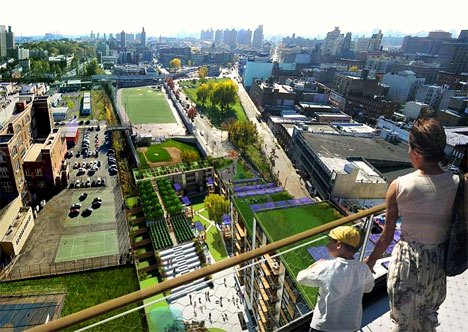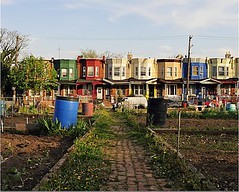Distressed city neighborhoods need green investment for community, environment
Distressed city neighborhoods, more than others, are deficient in environmental amenities, particularly those that are typically provided by nature. That is almost a tautology, but they especially need trees, pocket parks, rain gardens, vegetated swales, permeable pavements, roof gardens and other urban green infrastructure to provide multiple environmental and quality-of-life benefits. So says Pace University law professor Alexandra Dapolito Dunn in a terrific new article published in the Boston College Environmental Affairs Law Review.
(Today's post is co-authored with my NRDC colleague Rachel Sohmer, who has written here before on the benefits of urban nature and more.)
Among environmental professionals, city green infrastructure is usually discussed as a matter of stormwater management, and Dunn has written a particularly helpful introduction to the subject from that perspective. We wish she had also included an explanation of why low-density development isn't the answer, but the point here was to focus our attention on the other end of the development spectrum. Dunn believes that green infrastructure investments directed to the urban core would not just be good for the environment; they would help alleviate urban poverty.
As Dunn explains, many cities have already successfully implemented strategies to protect water resources, but "green infrastructure has additional and exceptional benefits which are not frequently highlighted or discussed. Not only can it achieve water quality goals, protect sewer systems, and recharge groundwater supplies, but it also can improve air quality, provide green collar jobs, become a source for affordable produce, reduce crime, promote community interconnectedness and reduce energy costs for the urban poor." But, for the most part, where green infrastructure could do the most good, you are least likely to find it.
Of course, none of the quality-of-life benefits linked with green infrastructure are specific to disadvantaged neighborhoods. They benefit neighborhoods of all sorts. But Dunn's implied point is that the absence of green infrastructure in pockets of poverty puts these already stressed communities at even greater risk. Take, for example, the higher cost of food. Low-income city dwellers must pay up to thirty percent more for food compared with low-income rural and suburban residents, primarily due to food transport costs and postharvest losses. And healthy foods, particularly produce, might not be available at all. Likewise, heavy air pollution loads contribute to high rates of asthma in poor urban communities, several times the national average.
Unfortunately, even though targeting green infrastructure programs in distressed urban areas could provide much benefit to communities in need, there are considerable legal and policy barriers in the way. As Dunn explains, retrofitting existing neighborhoods for green infrastructure isn't cheap, and cities and community development entities are often severely budget-constrained. Even when adequate funding exists, there may be a lack of political will to direct green infrastructure investments to areas where the resulting benefits, like neighborhood beautification, might be considered less visible.
So what can we do? Dunn reviews several big-picture, long-term strategies for getting more green infrastructure on the ground, from creating more public funding opportunities to refining cost/benefit models to battling political inertia with public awareness campaigns. That's not an exhaustive list – we highly recommend downloading the article for a closer look.
The good news is that several cities are leading the way in green infrastructure initiatives that benefit lower-income communities. The article mentions Seattle and Philadelphia, among others. Even at the federal level there is a growing recognition that green infrastructure is an effective and economical way to reach sustainable development goals. Dunn cites the American Recovery and Reinvestment Act (the "stimulus") of 2009, for example, which provides significant green infrastructure funding to states for water quality compliance purposes. To that we can add the recently introduced and NRDC-supported Green Infrastructure for Clean Water Act of 2009, which would establish several research centers, a dedicated green infrastructure program at the U.S. EPA, and grants to help communities – especially lower-income communities – implement their own green infrastructure projects.
No doubt we've got a long way to go, especially when it comes to meeting the complex challenges of distressed urban areas. But considering all that green infrastructure delivers, we remain optimistic that green infrastructure initiatives will only gain momentum and support going forward. As Dunn puts it, "given the growing stresses on urban centers and the urban poor, taking [steps] to make city life healthier and more sustainable can only yield further benefits in the future."
Thank you to our colleague Madeline Fraser Cook, director of the Green Development Center at the Local Initiatives Support Corporation, for flagging this article for us.
Kaid Benfield writes (almost) daily about community, development, and the environment. For more posts, see his blog's home page.
Link to original post



